In most schools, integrated curriculum is more a hit-and-miss practice than a full-scale, all-out commitment. To accomplish the goal of ensuring that “all teachers can identify the connections among ideas and fields of knowledge, as well as how their teaching relates to the courses and student activities conducted by other school personnel,” as AMLE’s This We Believe suggests, schools must establish protocols that help middle grades educators develop integrated lessons and units.
Getting Started
The first step in developing integrated lessons and units is to designate a planning time for teams to discuss ways to integrate each teacher’s curriculum. At Lee County Middle School, we chose Tuesdays. During that dedicated time, we plan and discuss short-term and long-term integration opportunities.
Short-term and long-term units are identified according to the length of time it takes to complete the unit. A longterm unit requires two or more weeks to complete; a shortterm unit requires anywhere from one day to one week in the regular classroom. (When integrated units require a more flexible schedule so students can work with each other or with students on other teams they utilize a period called “seminar” time.)
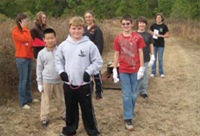
A meeting agenda helps focus all attendees and provides a framework for more productive outcomes. One of our teams was having a hard time planning an integrated curriculum, so we worked together to construct an agenda to steer the meeting. Discussions were guided by key questions.
1. Are there any student concerns we need to discuss?
Student issues that have nothing to do with integrating the curriculum often get team members off topic; therefore, we set some guidelines:
- Do not get bogged down in student issues. This discussion should be quick and specific. Remember, today’s meeting is about integrating curriculum.
- If you must discuss a problem or situation that concerns a specific student, do not use the student’s name. Instead, discuss the behavior, situation, or problem that should be addressed.
Now brainstorm ideas to solve the problem. Once the team has come up with a plan, put it on paper and determine how it will be implemented and how often the plan will be monitored.
2. What topics or standards are we teaching next week?
Each person on the team shares what he or she will introduce or teach the following week. Team members take notes about each member’s responses then review them for possible connections.
3. Is there an opportunity for any integration between or among the subjects?
Is there vocabulary that can be integrated across subject areas? Is there a concept that cuts across topics? Is there an opportunity for writing across the curriculum?
On one team, the math teacher planned to work on ratio and proportion the following week; the science teacher would teach about layers of the Earth; the social studies teacher would introduce gross domestic products, literacy rate, and economics; and the English language arts teacher would review parts of speech and strategies for reading informational text.
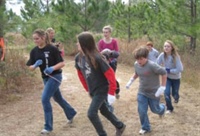
On the surface, none of the team members’ lessons seemed the least bit related. But once we started discussing how we could connect the content and the learning, we came up with some easy and fun integration opportunities.
We discussed how to incorporate ratio into each subject’s lessons. The teachers decided to begin with the vocabulary. They developed a ratio/proportion vocabulary list that each would introduce along with her own content-specific vocabulary. The integrated vocabulary was posted on a word wall with definitions and possible uses. (The same definitions are used in each class.)
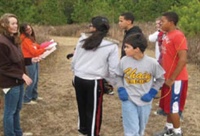
Math: The math teacher’s topic drove this unit, so she taught her original unit—no additional planning was necessary other than a discussion of how ratio/proportion is used in our daily lives.
The team decided science students would look at the make up of the layers of the Earth and develop ratios regarding the Earth’s composition. These ratio charts would be posted in the hall and in the classroom.
Because the students were studying gross domestic products (GDPs) and literacy rates, students would be broken into small groups. Each group would study the literacy rates and GDPs of the various countries covered in their standards. They would develop ratios of literate citizens to illiterate citizens and then make inferences regarding GDP and economics based on literacy rates.
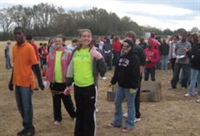
In English language arts (ELA), students were given informational text regarding GDP and literacy rates to read and determine important details and main ideas. This integration helped the social studies teacher because her students came to her having read much of the background information needed to understand her lesson.
The ELA teacher had also planned to review parts of speech; therefore, we devised a game for the students. Working in pairs on one paragraph from the informational text, students would label two specific parts of speech and develop a ratio for them.
This unit was a short-term (one week) integration. The students discussed ratio and proportion in every class. They gathered data and produced charts and graphs based on ratio, and they made inferences about a country’s GDP and economic strengths or weaknesses based on literacy rates.
In most schools, integrated curriculum is more a hitand- miss practice than a full-scale, all-out commitment. To accomplish the goal of ensuring that “all teachers can identify the connections among ideas and fields of knowledge, as well as how their teaching relates to the courses and student activities conducted by other school personnel,” as NMSA’s This We Believe suggests, schools must establish protocols that help middle grades educators develop integrated lessons and units.
4.What will our next long-term integrated unit be?
The team examined the long-term integrated unit they planned to teach. This time the ELA teacher’s curriculum anchored the unit.
The sixth grade ELA curriculum includes a study of world mythologies. Since the ELA standards do not specify which mythologies are to be taught, the team decided to use the mythologies of the countries presented in the social studies curriculum.
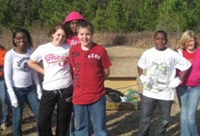
The students would be placed in “expert” groups for the ELA unit. Each expert group would study a different mythology and share its findings with other groups. The ELA teacher would use Greek/Roman mythologies to model what she wanted the students to learn in regard to the myths they were studying in their expert groups.
The science teacher looked at her curriculum and realized she could teach her space unit during the mythology unit. Her students would study the constellations as they relate to ancient mythologies. The students would create the “night” sky as it looked during important historical events related to their social studies curriculum. After placing the constellations in their correct positions for each event, students would compare their renderings, looking for patterns.
Since Central American countries are included in the social studies curriculum, the plan would allow the math teacher to discuss the importance of math in the building of the Mayan pyramids. Students would create scale drawings of the pyramids, research and discuss the mathematics needed to construct the pyramids, and measure the volume, square footage, and other geometrical aspects of the pyramids.
The teachers discussed the culminating task for this unit, developed a timeline for completing the unit, designated whole-team unit work days, and took an inventory of resources and supplies needed to complete the unit. Each teacher was given a specific task. During each Tuesday’s integrated unit planning time, the team would reflect on the unit and make needed adjustments.
Seminar Time
Seminar time is an outgrowth of fully integrated long-term units. To complete the seminar units, the teams carve out one to two hours weekly. During these times, the students work as an entire “team” of students rather than a “class” of students.
The integrated seminar units are usually designed around themes, but incorporate skills and content from each subject. One such unit is the space museum seminar. In this seminar unit, the students study the various aspects of space, including solar system, ancient astrology/astronomy, space travel, the development of NASA, future space exploration, and other topics of interest related to space. The culminating performance task for this unit is to develop a walk-through space museum that is informative and interesting for elementary students in grades 3-5.
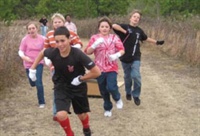
For six weeks the students with similar interests form cadres to research one of the topics. These cadres design displays and visuals for the museum. The displays must include written placards that show the students’ research.
After each cadre’s work is complete, an entire hallway is dedicated to the “museum.” Students create a space walk, covering the walls and ceilings with the various visuals they’ve created. Eighth grade students take the elementary students through the museum, sharing information and providing opportunities for the younger students to participate in the many interactive displays.
Another seminar unit is our Iditarod unit. The unit integrates physical science very nicely because it requires students to understand force, motion, acceleration, and friction.
For background information for this unit, students read Gary Paulsen’s Hatchet or Jack London’s Call of the Wild in their English language arts class. These books afford the teachers and students glimpses into the worlds of orienteering and dog sledding. Students also conduct extensive research about the Iditarod.
In the social studies class, students learn about the geography and terrain of the Iditarod trail, the indigenous peoples of the regions and their traditions and cultures, and the evolution of the Iditarod itself.
Math and science students are divided into teams. Each team must construct a sled from “found” objects—most often large, cardboard boxes and lots of tape. Each team’s sled must be built to provide the least friction and most acceleration because the students actually participate in a mock Iditarod.
Student research about the race is recorded on posters and informational text hung in the hallways for other students, teachers, and visitors to read.
As part of the culminating activity for the Iditarod, parents are invited to watch the race. Dogs (students with socks on their “paws” for mittens) and sled drivers line up in anxious anticipation. It is amazing to watch eighth grade boys and girls (who are usually too cool for anything school initiated) screaming and yelling with enthusiasm and excitement as they get caught up in the competition between sled teams.
Our school is team-driven to observe common planning time, team decision making, flexible scheduling, and full curriculum integration when appropriate. Seminar time was so popular that seminar time and seminar units have been adopted by many other teams in our school.
Final Thoughts
Constrained by the state-mandated curriculum, teachers often do not recognize opportunities for integrating learning. However, with intentional planning and collaboration, integrating curriculum can become second nature.

I love how there is time for the teachers to meet up and use each other content areas in other classes. Also, the sample questions to discuss in a meeting of multiple different teachers. The idea of placing content areas into teams is I great idea that I have seen, but never though anything about until now.
I think that having a designated time for teachers from different content areas to speak about what content is being taught is a very important thing for schools to implement. Being able to integrate topics from different content areas is beneficial to student learning and understanding. This can be difficult for teachers to do when there isn’t a designated time for them to have these specific conversations.